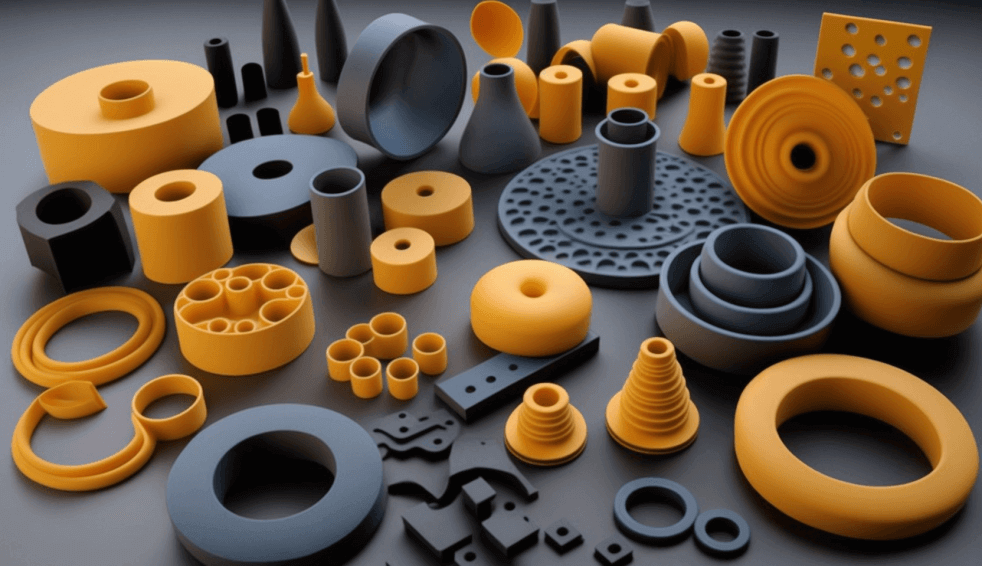Rubber Products Manufacturer

Contact : +91 97404 04503
Rubber Products Manufacturing: An Overview
Introduction
Rubber products manufacturing is a vital segment of the global industrial landscape, playing a crucial role in numerous applications across various sectors. From automotive components and medical devices to consumer goods and industrial machinery, rubber products are essential for their durability, flexibility, and resilience. This industry encompasses the production of items from natural and synthetic rubber, each offering distinct properties suited to different uses.
Raw Materials
Rubber products are primarily made from two types of raw materials: natural rubber and synthetic rubber. Natural rubber is derived from the latex of rubber trees (Hevea brasiliensis) and is valued for its elasticity and strength. Synthetic rubber, on the other hand, is produced from petrochemical feedstocks and can be engineered to meet specific performance criteria. The most common types of synthetic rubber include styrene-butadiene rubber (SBR), nitrile rubber (NBR), and ethylene-propylene-diene monomer (EPDM). Each type has unique characteristics that make it suitable for particular applications.
Manufacturing Processes
The manufacturing process of rubber products involves several key steps:
-
Compounding: This initial stage involves mixing rubber with various additives, such as accelerators, fillers, plasticizers, and curing agents. The purpose of compounding is to enhance the properties of the rubber, such as its strength, elasticity, and resistance to wear and tear.
-
Forming: Once compounded, the rubber is shaped into the desired form. This can be achieved through different methods, including extrusion, molding, or calendaring. In extrusion, the rubber is forced through a die to produce continuous shapes like hoses or seals. Molding involves placing rubber into a mold cavity where it is shaped under heat and pressure. Calendaring is used to produce thin sheets or films of rubber.
-
Curing (Vulcanization): After forming, the rubber undergoes curing, a chemical process that cross-links the rubber molecules to improve its strength and elasticity. This process is commonly referred to as vulcanization. During vulcanization, rubber is heated with sulfur or other curing agents, which form bridges between the polymer chains, enhancing the material's durability and performance.
-
Finishing: The final stage involves trimming, surface treatment, and quality inspection. Finished products are often tested for various parameters, including tensile strength, elasticity, and resistance to environmental factors. This ensures that the products meet the required specifications and standards.
Applications
Rubber products are used in a wide array of applications:
-
Automotive Industry: Rubber is essential for tires, gaskets, seals, and suspension components. Its ability to withstand extreme conditions and absorb vibrations makes it ideal for automotive applications.
-
Medical Field: Rubber products such as gloves, catheters, and seals are critical in medical and pharmaceutical applications due to their hygienic properties and flexibility.
-
Industrial Applications: Rubber is used in machinery parts, conveyor belts, seals, and hoses. Its resistance to abrasion and chemicals makes it suitable for harsh industrial environments.
-
Consumer Goods: Everyday items like rubber bands, footwear, and household appliances often incorporate rubber components for their durability and comfort.
Challenges and Innovations
The rubber products manufacturing industry faces several challenges, including fluctuating raw material prices, environmental regulations, and the need for continuous innovation. Companies are investing in research and development to create more sustainable rubber materials, improve manufacturing processes, and develop new applications. Innovations such as biodegradable rubbers, enhanced recycling techniques, and advanced composite materials are shaping the future of the industry.
Conclusion
Rubber products manufacturing is a dynamic and essential industry with far-reaching impacts across various sectors. By leveraging advancements in materials science and manufacturing technology, the industry continues to evolve, meeting the growing demands for high-performance and sustainable products. As technology progresses and environmental considerations become more prominent, the industry is poised to adapt and thrive in the coming decades.
